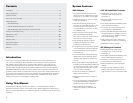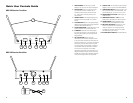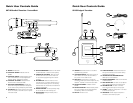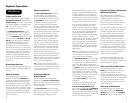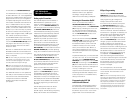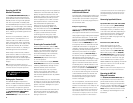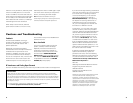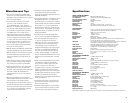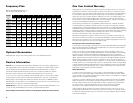
14 15
Cautions and Troubleshooting
Feedback
Avoid acoustic feedback (howling or
screeching) by taking care in selecting
PA volume, transmitter location and
speaker placement.
Please also note the pickup pattern
characteristics of the microphone selected.
Unidirectional microphones are more
resistant to feedback. However, they pick
up sound sources best that are directly in
front of the microphone. Also, mics that are
farther from the sound source (such as a
handheld) require more acoustic gain and
thus are also more prone to feedback than
close-source mics.
No or Low Audio
If you are not getting audio through the
system, carefully re-check all setups.
Especially note that the receiver and
transmitter must be set to operate on
the same RF channel. Also confirm that
the transmitter’s POWER OFF/STBY/ON
SWITCH (18, 25) is not in the STBY position.
The receiver’s UNBALANCED LINE OUT (11)
is adjustable so make sure the VOLUME
CONTROL (12) is set properly.
RF Interference and Finding Open Channels
The FCC mandates the following information be provided to all end users of this equipment:
Consumer Alert
Most users do not need a license to operate this wireless microphone system. Nevertheless,
operating this microphone system without a license is subject to certain restrictions: the system
may not cause harmful interference; it must operate at a low power level (not in excess of 50mW);
and it has no protection from interference received from any other device. Purchasers should also
be aware that the FCC is currently evaluating use of wireless microphone systems, and these rules
are subject to change.
For more information, call the FCC at 1-888-CALL-FCC (TTY: 1-888-TELL-FCC)
or visit www.fcc.gov/cgb/consumerfacts/wirelessmic_factsheet.html.
If you encounter slight receiving interference
when the transmitter is far from the receiver
(from other than an operating TV station
on the same frequency), it can often be
overcome by adjusting the receiver‘s
MUTE LEVEL/SQUELCH (16)—see Adjusting
the Squelch. If receiving interference on
a selected channel with the transmitter
off, you must reprogram the receiver and
transmitter to a different channel.
To reprogram, you must first find an open
channel. To do this, follow the procedure
outlined in Selecting the UWS-100 Receiver
Channel. With the associated transmitter
off, scroll through the channels to find one
that shows no received signal (not lit) on
the receiver’s RF A/B LEDs (5). Also, neither
of these LEDs should be lit on each of the
three immediately adjacent channels both
above and below the selected channel for
optimal interference-free operation (i.e. in a
field of seven total adjacent channels—with
the channel used in the middle).
If operating multiple UWS-100 Series
systems simultaneously, repeat this
procedure with every new channel being
selected, with previously tuned systems all
on, both transmitters and receivers. See
“Instructions for Setup of Simultaneous
Multichannel Operation “
Also see:
Selecting the UWS-100 Receiver Channel
Programming the UH-100 to the
Selected Channel
Programming the UB-100 to the
Selected Channel
Please note that wireless frequencies are shared
with other radio services. According to FCC
regulations, wireless microphone operations are
unprotected from interference from other licensed
operations in the band. If any interference is
received by any Government or non-government
operation, the wireless microphone must cease
operation or change frequencies. The above
statement is valid only for use in the U.S.A.
After the unit is powered on, slide the power
switch to the ON position to un-mute the
audio or to STBY to mute the audio. Set the
power switch accordingly and the transmitter
is now ready to use. The receiver’s RF A/B
LED indicator should now be on, indicating a
received signal from the transmitter.
When ready to transmit audio, slide the
power switch to ON to un-mute. To mute,
slide the power switch to STBY again. Adjust
the volume of the receiver per the previous
section, Connecting the Audio Output.
Note: Avoid acoustic feedback (howling or
screeching) by taking care in selecting PA volume,
transmitter location and speaker placement.




